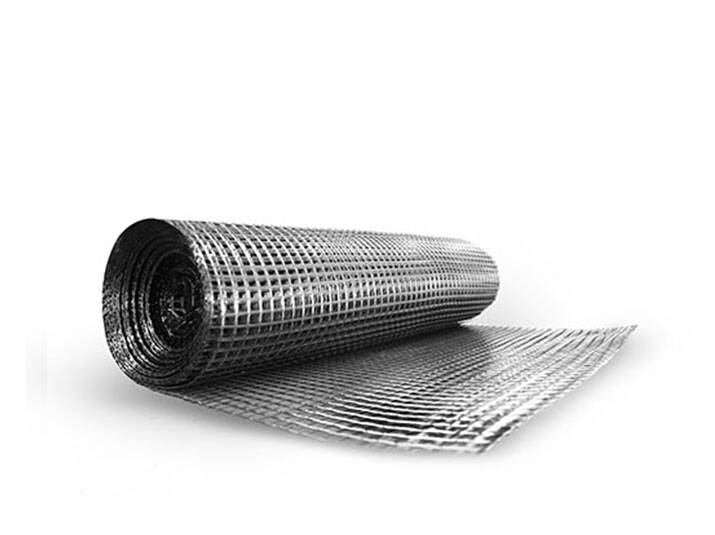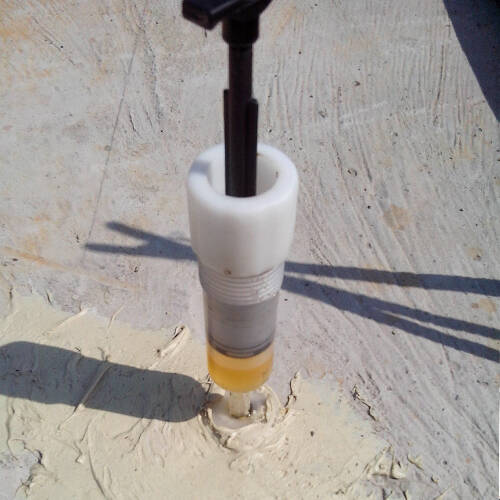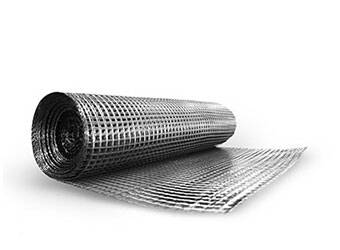Solutions
Horse Construction offers full range of structural strengthening materials with technical supports, documentation supports, products supports, project supports.
How To Strengthen Stone Components?
Reinforcement of stone components is extremely common in the construction industry. Due to the characteristics of stone, it is prone to hidden dangers such as loose structure and many cracks. Today, we will communicate with everyone in combination with stone reinforcement methods.
1. "Back Net" Reinforcement
"Back net" reinforcement refers to bonding a high-strength fiber protection net (mesh size is generally 5×5mm) to the back of the stone plate through epoxy resin, and then the strength of the plate is strengthened after drying. The width of the whole roll of fiber protection net is divided into different specifications from 1.2-1.8m, and the weight is generally about 900g/㎡.
According to the actual needs of the board, the "back net" reinforcement process can be used to reinforce various large and thin slabs such as marble, granite, limestone and onyx that need to be reinforced.
In the case of relatively low glue viscosity, it generally takes 6-9 hours to achieve curing at room temperature. If the heating method of a drying oven is used, the time for complete curing can be significantly shortened.
When the ambient temperature is too low, the glue will thicken and the curing speed will slow down. You can heat the glue, heat the stone or increase the temperature of the construction environment to make the glue thinner and speed up the curing speed.

It is worth noting that the ideal curing temperature of the glue is 25℃~75℃; when the temperature is too low in winter, try to heat and cure it to get a better curing effect.
The setting time is an important process parameter for back-net-reinforced stone slabs. It depends on the number and output of back-net-reinforced slabs, the operation method of the back-net process, and whether to choose a drying furnace or the drying capacity of the drying furnace .
If the number of plates to be reinforced in the production line is large and the output requirements are high, the mechanized back net reinforcement method can be used, the natural complete curing method at room temperature, or the flat-plate curing and heating drying oven can be used. If the output is very demanding, you can even choose a vertical drying oven.
For some production lines with small reinforcement and low output, manual back net operation and normal temperature natural complete curing method can be adopted.
2. Surface penetration and reinforcement
There are many micro-cracks on the surface of some stones, and some micro-cracks even go deep into the stone. Although they have been reinforced, their strength still cannot meet the requirements of grinding and polishing or the requirements of the finished product.
At this time, the surface must be selected for penetration and reinforcement. The frontal penetration reinforcement process includes penetrating the highly penetrating epoxy resin AB glue into the gaps on the surface of the board, drying it, and then grinding and polishing.
Epoxy resin AB glue is used for surface penetration reinforcement. Here we use high-strength penetration glue as an example. The curing temperature of this glue is also 25℃, the minimum curing temperature is 10-15℃, and the curing time at room temperature needs 4-6 hours. In the stone production line equipped with automatic repairing and drying units, all drying equipment adopts flat-plate horizontal drying oven or vertical vertical drying oven, and high-temperature curing treatment is carried out on the stone after surface penetration and strengthening to speed up the complete curing of the glue. . For some simple stone production lines with low output requirements, natural curing at room temperature can be used, but it is best to proceed to the next process after curing for 24 hours.
Because of the wide variety of stone and the different color depths, the surface penetration and reinforcement treatments are all carried out on the surface of the board. Therefore, when selecting the high-strength penetrating glue used for the surface penetrating treatment of the board, it must be considered that its color is the same as the color of the board, or can be reasonably matched. There should be no traces of high-strength penetrating glue after the reinforcement treatment. This is to color the high-strength penetrating glue. The color paste selected at this time is preferably epoxy color paste or color paste, so as not to affect the curing and use performance of the glue.
Natural facing stone is first mined from mines into blocks, then sawn into rough slabs in a stone processing plant, and then ground, polished, and cut. About 30% of stone blocks have problems such as loose and porous structure, wide and deep cracks. During the transportation of blocks, especially in the process of sawing and cutting into rough boards, they are easily broken into waste stones, causing a huge waste of natural resources and causing significant economic losses to stone companies.
Insiders have explored and practiced many methods on how to reinforce the blocks and ensure the sawing rate.
There are currently two more conventional methods on the market: manual infusion and external wrapping.
For blocks with obvious holes and large cracks, most manufacturers use simple equipment such as syringes or grease guns to inject glue into them, so that they can strengthen the bonding after curing.
Although the process operation is simple, it has the disadvantages of low efficiency and easy leakage of the glue and waste. More importantly, the penetration depth of the glue into the cracks is limited, and the effect of the internal reinforcement of the block is not satisfactory. There is another reinforcement method that is currently the mainstream in the market-external wrapping. Adopt glass fiber reinforced material and polymer glue material (epoxy resin or unsaturated polyester resin) to stick together to strengthen the outside of the four sides of the block.
Through the surrounding wrapping reinforcement, it can basically prevent the blocks from missing edges and corners during the sawing process. However, for the inside of the block, especially the block with developed internal fissures, the enhancement effect is very small. During the sawing process, the strong back and forth vibration of the saw blade will cause the originally loose and cracked internal stones to fall, resulting in jamming or even collapse. This phenomenon seriously affects normal production.
Third, the process of vacuum impregnation and reinforcement of blocks
In this process, the whole block to be reinforced is soaked in a cylinder full of glue, and the block is placed in a vacuum tank along with the block, and the vacuum operation is performed to allow the glue to fully penetrate into the block. Then the blocks are heated and then solidified, so as to have a good reinforcement effect on the blocks from the inside to the outside.
However, the operation of this process requires large-scale special equipment to assist, the efficiency is low, the requirements for glue are high, the waste is large, the cost is difficult to control, and only a few varieties of blocks are applicable, so they have not been widely promoted.
High pressure perfusion

As the name suggests, high-pressure infusion is a process in which special glue is injected into the block with pressurized equipment, and after it is cured, it can strengthen the block. This process seals the cracks of the blocks, selects suitable glue injection points, and uses special equipment with a pressure of up to 30kg to ensure that the entire infusion process is controllable and the crack filling rate is high, so as to ensure that the blocks can be reinforced to achieve smooth sawing. The main equipment for high-pressure perfusion includes high-pressure perfusion machine and air compressor. The main materials are glue injection nozzle, crack sealant, block filling glue, and cleaning agent.
Therefore, crack sealing requires strict and meticulous operation so as not to affect subsequent processes and reduce efficiency. Connect the glue outlet of the high-pressure glue filling machine to the glue nozzle, and tighten it to fix it. Open the high-position glue nozzle plug on the same crack to empty, and mix the glue in the mixing container above the glue machine according to the proportion. Start the air compressor and open the air valve for high-pressure injection of glue. When there is glue leakage at the high-position glue nozzle to be vented, close the air valve to stop the glue. Remove the glue outlet joint of the high-pressure glue filling machine from the glue nozzle, and quickly plug it with the vent with a plastic plug and seal it well. At this point, the crack has been fully glued, and only needs to be left to fully cure. Repeat the above operation for other cracks.
You can find anything here you are in need of, have a trust trying on these products, you will find the big difference after that.

High strength, unidirectional carbon fiber wrap pre-saturated to form a carbon fiber reinforced polymer (CFRP) wrap used to strengthen structural concrete elements.

High strength carbon fiber reinforced polymer (CFRP) strip / laminate / plate for structural strengthening and concrete repair

HM-CFN is net alike strengthening fabric which made of carbon fiber tow. As the substitutes of steel mesh, it can be used together with epoxy motar to seal and control the crack, and improve the load capacity of the original structurers